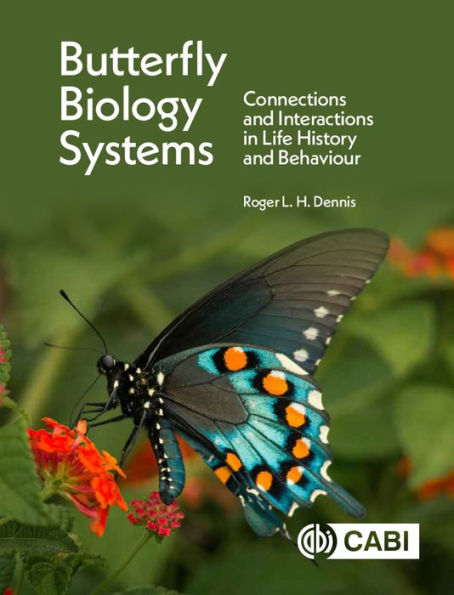Home
Butterfly Biology Systems: Connections and Interactions Life History Behaviour
Barnes and Noble
Loading Inventory...
Butterfly Biology Systems: Connections and Interactions Life History Behaviour
Current price: $242.10

Barnes and Noble
Butterfly Biology Systems: Connections and Interactions Life History Behaviour
Current price: $242.10
Loading Inventory...
Size: Hardcover
*Product information may vary - to confirm product availability, pricing, shipping and return information please contact Barnes and Noble
Butterflies, among key animals for assessing environmental changes, have consequently also become prominent model organisms for the study of trade-offs in life history and behavioral traits. Examples include factors affecting the size of egg batches, fast or slow larval growth, waiting or searching for mates, migrating or staying put in the habitat, roosting alone or together in aggregations, and the development of different defense mechanisms. The book focuses on the factors and trade-offs leading to the development and evolution of distinct traits emerging in the life cycle of butterflies within their habitats. The reader is taken systematically through research findings in each life history stage, on the links identified between different aspects of butterfly biology that have been discovered, and introduced to novel ideas emerging from taking an integrative view of butterfly life history and behavior.
The book is divided into four sections:
A: Language and concepts of system's theory
B: Perspectives on butterfly biology
C: Butterfly life history - basic trade-offs in reproduction, development and survival
D: Butterfly behavior - interactive adjustments in the habitat
The first section deals with the study of relationships in biological systems. The second is an introduction to key aspects of butterfly biology, such as broad issues in taxonomy, the fossil record, variation in space-time, habitat and niche, and the butterfly body frame. The last two longer sections deal directly with the key puzzles in life history and behavior.
The book has been composed primarily for students and researchers in butterfly biology, but it should be of interest to all those who enjoy observing butterflies. For the researcher into butterfly biology it is supported by an extensive glossary and bibliography and, to encourage incentives for ideas, it is liberally illustrated with diagrams for exploring in greater depth the relationships in butterfly biology.
The book is divided into four sections:
A: Language and concepts of system's theory
B: Perspectives on butterfly biology
C: Butterfly life history - basic trade-offs in reproduction, development and survival
D: Butterfly behavior - interactive adjustments in the habitat
The first section deals with the study of relationships in biological systems. The second is an introduction to key aspects of butterfly biology, such as broad issues in taxonomy, the fossil record, variation in space-time, habitat and niche, and the butterfly body frame. The last two longer sections deal directly with the key puzzles in life history and behavior.
The book has been composed primarily for students and researchers in butterfly biology, but it should be of interest to all those who enjoy observing butterflies. For the researcher into butterfly biology it is supported by an extensive glossary and bibliography and, to encourage incentives for ideas, it is liberally illustrated with diagrams for exploring in greater depth the relationships in butterfly biology.
Butterflies, among key animals for assessing environmental changes, have consequently also become prominent model organisms for the study of trade-offs in life history and behavioral traits. Examples include factors affecting the size of egg batches, fast or slow larval growth, waiting or searching for mates, migrating or staying put in the habitat, roosting alone or together in aggregations, and the development of different defense mechanisms. The book focuses on the factors and trade-offs leading to the development and evolution of distinct traits emerging in the life cycle of butterflies within their habitats. The reader is taken systematically through research findings in each life history stage, on the links identified between different aspects of butterfly biology that have been discovered, and introduced to novel ideas emerging from taking an integrative view of butterfly life history and behavior.
The book is divided into four sections:
A: Language and concepts of system's theory
B: Perspectives on butterfly biology
C: Butterfly life history - basic trade-offs in reproduction, development and survival
D: Butterfly behavior - interactive adjustments in the habitat
The first section deals with the study of relationships in biological systems. The second is an introduction to key aspects of butterfly biology, such as broad issues in taxonomy, the fossil record, variation in space-time, habitat and niche, and the butterfly body frame. The last two longer sections deal directly with the key puzzles in life history and behavior.
The book has been composed primarily for students and researchers in butterfly biology, but it should be of interest to all those who enjoy observing butterflies. For the researcher into butterfly biology it is supported by an extensive glossary and bibliography and, to encourage incentives for ideas, it is liberally illustrated with diagrams for exploring in greater depth the relationships in butterfly biology.
The book is divided into four sections:
A: Language and concepts of system's theory
B: Perspectives on butterfly biology
C: Butterfly life history - basic trade-offs in reproduction, development and survival
D: Butterfly behavior - interactive adjustments in the habitat
The first section deals with the study of relationships in biological systems. The second is an introduction to key aspects of butterfly biology, such as broad issues in taxonomy, the fossil record, variation in space-time, habitat and niche, and the butterfly body frame. The last two longer sections deal directly with the key puzzles in life history and behavior.
The book has been composed primarily for students and researchers in butterfly biology, but it should be of interest to all those who enjoy observing butterflies. For the researcher into butterfly biology it is supported by an extensive glossary and bibliography and, to encourage incentives for ideas, it is liberally illustrated with diagrams for exploring in greater depth the relationships in butterfly biology.

















